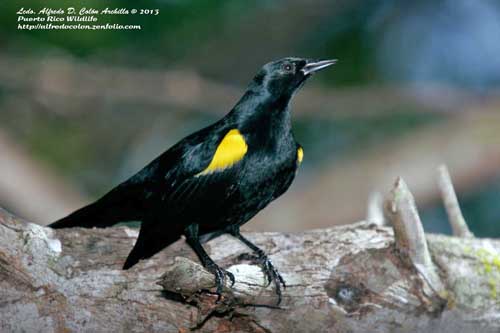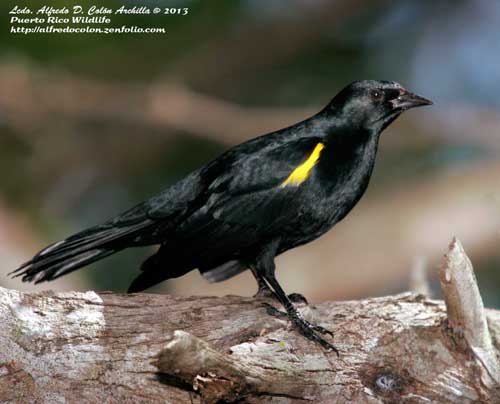
Fr: Carouge de Porto Rico
All: Gelbschulterstärling
Esp: Sargento Puertorriqueño
Puerto Rico: Mariquita
Ita: Carouge de Porto Rico
Nd: Geelschoudertroepiaal
Sd: Gulskuldrad trupial
Photographer:
Alfredo Colón
Puerto Rico Wildlife
Text by Nicole Bouglouan
Sources:
HANDBOOK OF THE BIRDS OF THE WORLD Vol 16 by Josep del Hoyo- Andrew Elliot-David Christie – Lynx Edicions – ISBN: 9788496553781
NEW WORLD BLACKBIRDS – THE ICTERIDS by Alvaro Jaramillo and Peter Burke – Helm - ISBN : 0713643331
BirdLife International (BirdLife International)
Neotropical Birds – Cornell Lab of Ornithology
Aves de Porto Rico – Sociedad Ornitológica Puertorriqueña
Wikipedia, the free encyclopaedia
Yellow-shouldered Blackbird
Agelaius xanthomus
Passeriformes Order – Icteridae Family
INTRODUCTION:
The Yellow-shouldered Blackbird is endemic to Puerto Rico and evaluated as Endangered species, due to restricted range and various threats. Currently, conservation measures are active and the population appear fairly stable and increasing slowly.
DESCRIPTION OF THE BIRD:
Biometrics:
Length: 20-23 cm
Weight: 38g
The adult male of nominate race has black plumage with bluish gloss, except the bright yellow shoulder patch formed by the yellow tips of lesser and median upperwing coverts.
The strait bill is black. The eyes are dark brown. Legs and feet are blackish.
The female has similar plumage, but she is slightly smaller than male.
The juvenile has duller plumage, rather brownish-grey than black, and the shoulder patch is paler and smaller.
SUBSPECIES AND RANGE:
We can find two subspecies:
A.x. xanthomus (here described and displayed) is found in Puerto Rico
A.x. monensis is found on Mona Island, off W Puerto Rico. This race has paler shoulder patch, more yellowish-white.

HABITAT:
The Yellow-shouldered Blackbird frequents coastal mangroves and small mangrove islands. It is also found in adjacent pastures and palm plantations.
The race “monensis” frequents the coastal cliffs on Mona Island.
CALLS AND SONGS: SOUNDS BY XENO-CANTO
The Yellow-shouldered Blackbird’s common call is a “check” or a more nasal “chwip”. Both are given while the bird flicks its tail. During aggressive behaviour, it gives a raspy “vvvt”. When disturbed at nest, it produces a scolding “greeah”. The alarm call is a rising and descending “cut-zee”.
During displays, the “wing-raising” is accompanied by a descending “queeaa”. Both mates communicate by sweet, rising and descending “pee-puu”.
The song is a short, nasal “nhyaaaaaaaaa” accompanied by “song-spread” and “wing-raising” displays. Male and female sing, and sometimes, several birds sing together as a group chorus.
The take-off is accompanied by a series of calls such as “cut-zee, queea, pee-puu and chwip” notes, named “flight series”.
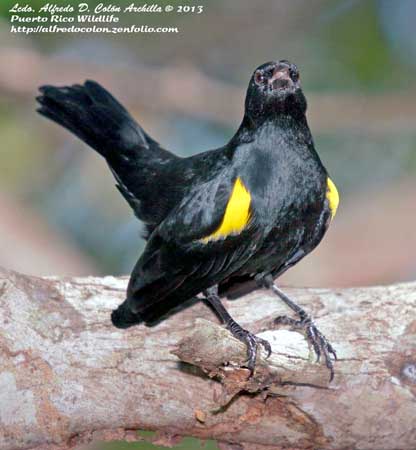
BEHAVIOUR IN THE WILD:
The Yellow-shouldered Blackbird feeds mainly on insects such as moths and crickets. It also takes nectar from flowers, fruits of cactus and seeds.
It forages in trees by probing among bark and vegetation, and on the ground too.
Outside the breeding season, large flocks congregate at feeding sites, whereas during the nesting period, it remains in the vicinity of the nest and forages in mangroves and adjacent pastures, and in sub-canopy of trees.
The Yellow-shouldered Blackbird is monogamous. The pair forms in late March. Usually, the male displays at the nesting-site of the previous year. It follows females and sings from the nest-site. It becomes more aggressive as it defends females from rivals.
The main display is the “song-spread”, involving lowered bill, raised wings, fanned tail and fluffed plumage. It moves its wings in order to expose the yellow wing patches. This display is accompanied by song.
The “wing-raising” is fairly similar but with less exaggerated postures. This display may be performed in quick succession and accompanied by calls. The “bill-tilt” is an aggressive display during which the male points the bill upwards.
When the female begs for food from the male, she flutters her wings. This is also used as pre-copulatory display with raised tail.
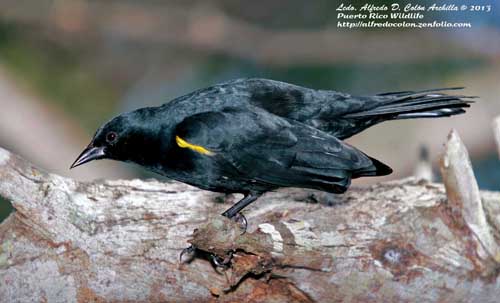
During aggressive encounters, the birds may jab at each other with the claws. They also beat their wings on each other. They may engage communal mobbing against predators, in order to protect females and eggs.
The Yellow-shouldered Blackbird is sedentary. It uses the same communal nightime roost all year round.
It often flies in flocks and may travel long-distances between the roost and the feeding areas. The yellow wing patches are conspicuous in flight.
REPRODUCTION OF THIS SPECIES:
The breeding season occurs between April and August. The Yellow-shouldered Blackbird nests in small colonies of 4-6 pairs, about 15-16 metres apart from each other. They breed on small offshore islands, abandoned salt ponds, mangroves, palm groves and trees in pastures.
The race “monensis” breeds between February and November, and nests on sea-cliffs on Mona Island.
The female builds the cup-shaped nest with various materials found in the surroundings, such as grass, roots, seaweeds, feathers, but also string and pieces of paper and plastic. The inner cup is lined with fine, softer grass.
The nest is placed in tree hole, in cavity or crevice in sea-cliffs, or on tree branch. It may use artificial nest-boxes.
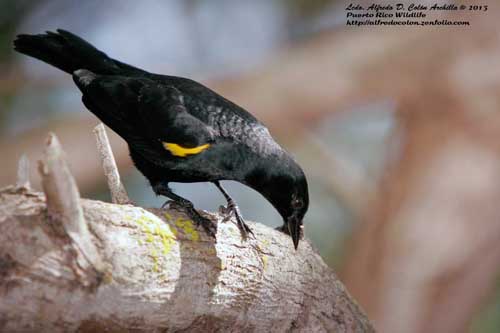
The female lays 1-4 blue-green eggs with brown markings. She incubates alone during 12-13 days, and she is fed by the male during this period.
The chicks are fed by both parents. They fledge about 13-16 days after hatching.
The Yellow-shouldered Blackbird’s nests are often parasitized by the Shiny Cowbird, and the pair rears the chicks of the cowbird.
PROTECTION / THREATS / STATUS:
The Yellow-shouldered Blackbird has restricted range where it is uncommon, local or rare. The species suffered, and is still threatened by brood parasitism, habitat disturbance, clearance for agriculture, nest predation by the Pearly-eyed Thrasher and mortality by introduced predators.
Active conservation measures include installation of artificial nest-boxes, breeding monitoring, control of Shiny Cowbirds and introduced predators, and habitat management.
Populations are slowly recovering, but the species is currently listed as Endangered.
